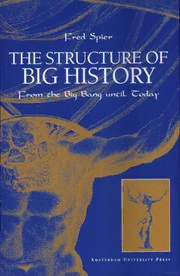
The Structure of Big History from the Big Bang Until Today PDF
Preview The Structure of Big History from the Big Bang Until Today
The Copyrightedimage Copyrighiedmaterial TheS Big H- of FromtheBigBanguntilToday FRED Spier Amsterdam University Everyefforthas been made to obtain permission for all copy- righted illustrations usedin this book. Nonetheless, whosoever believestohaverightstothismaterial is advised to contact the publisher. Coverillustration: Detail from "Afl^eeldingvan 'tStadtHuysvan Amsterdam", by HuhertusQiiellinus(1661-1668). Coverdesign: Marjan Wijsbeek,Pro Studio, Loosdrccht Typesetting: KronosPublishingAssistance,Amersfoort ISBN9053562206 ©FredSpier/rVinsterdamUniversityPress,Amsterdam, 1996 All rights reserved. Withoutlimiting the rights undercojnright reserved above, no part ofthis book ma\' be reproduced, stored in or introduced into a retrieval system, or transmitted, in any torm or by any means (electronic, mechanical, photocopving, recording, orotherwise), withoutthewritten jiermissionofboth thecopyrightownerandtheauthorofthisbook. Contents PRRFACRAND ACKNOWLEDGMENTS VU I GENERAL APPROACH I TnrroHiicHnn Z Regimesasstructuringelementsfor 2 cosmic,planetaryand humanhistory Humanregimes 5 Inorganicregimes 75 II HUMANLIEE BETWEENMICROAND MACRO 11 REGIMES H Introduction M Astronomical regimes Organicandbiologicalregimes 24 HUMANCULTURAL REGIMES U III Introduction ?? Humanecologicalregimetransformationsas 38^ themajorstructuringprincipleofhuman history 5 IV Threem^jorecologicalregimetrans- 4s FORMATIONSASSTRUCTURINGPRINCIPLE FORHUMANHISTORY Thefirstgreatecologicalregimetransformation: 4S thedomesticationoffire Thegadierer-huntersocialregime 49 Sedentarygatherersandhunters S2 Thesecondgreatecologicalregimetransfbrma- f tion:thetransition toanagrarianregime Theevolvingagrariansocialregime 62 Agrariansocialregimedifferentiationand 67 development Thethirdgreatecologicalregimetransforma- 77 don:thetransitiontowardanindustrialregime Socialregimetransformations 80 Planetaryecologicalregimedevelopment 81 SUMMARYAND CONCLUSIONS 8S NOTES 89 References 97 VI Copyrightedmalarial and Preface acknowledgments At the University ofAmsterdam, the sociologistJohan Gouds- bloniiindnivscU,abiochemist,anthropologistandhistoricalsoci- ologistbytraining,areorganisinganinterdepartmentalcoursein what Australian historian David Christian calls ''Big History". Thatis: an overviewofall knownhistoryfromthe begimiingof the Universeuntil liteon Earthtoday. OurcurriculumhasbeenmodelledonthecourseAnIntro- duction to WorldHistory set up by Davitl Christian at Alacquarie University, Sydney, Australia (see: Christian 1991). We have adapted his apj^roach with the aid ofour emergingsociological structuringprinciples,whilerevisionotthecontentshasbenetited from comments by contributing lecturers, whose specialities range from astronomy to the social sciences. While we have thoughtaboutand tosomeextentdiscussedthequestion ofhow tostructurethissummary^ofcosmic,planetary,worldandhuman historyforanumberofyearswithinourowncircles,wehavenot yet written anything about it. Goudsblom has outlined some of hisviews on howtostructure thehistoryofhumamtyinHuman HistoryandSocialProcess(Goudsblometal. 1989). In this book, I will advance one single, all-encompassing, theoreticalframeworkforbighistory.Theneedforsuchascheme arosewhileconsideringhowtointegrateintoourcourseportions ofscientific knowledge that are usually widely separated. As a result of this specialisation, the various academic disci|)Iines involved,rangingfrom astronomytothesocial sciences,haveall developed their own distinct theories, vocabularies and termin- ologies. And since veryfewpeople attempt to bring togetherall these formsofhistorical knowledge,theneedforasinglestruc- turingscheme is rarelyfelt. It is therefore notsurprisingthat, as far as 1 know, no one before hassuggestedsuch an outline. However, we thinkwe live inonesingle,undividedUniverse,withinonesingleSolarSystem, ononesingleplanet,asonehumankind,which,likeallotherliv- vn ingspecies, hasdescendedfromonesinglelifeform. Inorderto graspthisunityadequately,weneedatypeofunifiedknowledge thatisnotsplitalongdiefaultlinesofacademicspecialisations, whichdevelopedaspartofoursocialhistory.Ifwewishtoreach acomprehensiveunderstandingofourbigpast, we mustdevise onesinglesyntheticschemethatallowsustocombineallexisting theoretical and factual knowledge. This is, ofcourse, a most ambitious enterprise. It hardly needs savinu tliai in no way do I claim to have written the final word in this respect. Because no scholarly tradition exists of designmg "Cirand L nified Theories ofthe Past", such schemes can (Milybecomeestablishedattera longand thorough acadennc discussion. In addition, in manydisciplines, scientific knowledge is rapidly de\eloping. This will almost inevitabh lead to a need forreiliiiikingthisschemesomewherein the future. However, we livenow, and mustmakedowith ourexisting knowledge.Asa result, mythef)retical approach mustbe consid- ered a first attempt at uniting sections of scientific historical knowledge that have grown apart h)r centuries, if not longer. I thinkthetimeisripeforsuchaneffort. In almostall branchesof acadenncthought,the historical approachisgainingground.We nowhavetodeviseanoverarchingscheme unit\ingall these his- ntoereidc.alYahpcprUoSachweosr.ldI haimstonroitanthWe iolnlhiamonIIe. wMchNoeiplelr,cewihveislesuccohm-a mentingonourproject, h)rmulated itasfollows: "themeetingof hard and soft sciences is much needed. Itelevates histor\ to the Queenofthe Sciences: an interestingreversalfromitsstatusasa would-besciencein the 19th century". W^hateverthereceptit>notm\ piojxjsal, torme,atleast,the effort ot producing the scheme presented in this book has con- tributedconsiderablytostructurmgourcourseinbighistoryand, asa result, tostructuringourapproach toall history itself. This text is an improved and enlarged version ofa paper presented at the 1995 Annual Conference ot the World History Association in Florence, Italy. I have greatly profited from con- tributions to our course as well as from critical suggestions by astronomer Ed van den Heuvel, geologist HarryPriem, palaeo- biochemist Peter Westbroek, palynologist and palaeoclima- tologist Henry Hooghiemstra, biologist Frederick Schram, eth- ologist Adriaan Kortlandt, and archaeologistJos Deeben. Ihe vm Copyrightedmalarial worldhistoriansDavidChristianandWilliamMcNeill, ocean- ographerJamesKennett,sodalscientists^^ImaAarts,MartBaz, AnnBuddey,JohanGoudsblomJohanHeilbron,EstellieSmith, Ruud Stokvis, Abram de Swaan, Nico Wilterdink, chemistry teacherGijsKalsbeekandbiologystudentFilipaVala provided valuable references, fascinating suggestions, critical comments andinvaluablesupportforanenterprisethatseemedimpossible andhopelessly difficultwhenIfirstbeganthinkingalongthese lines.DavidChristian,inparticular,mademanyvaluablesugges- tions and provided invaluable inspiration and support. Both David Christian and Alison Fisher corrected the English. Of course,Iremainfiillyresponsibleforboththesyntaxandthecon- tents. IdedicatethisbooktoJohanGoudsblomv/ho,morethan anyoneelse,hashelpedmetogetonthetracktowardbighistory. DC Copyrightedmaterial CHAPTERI General approach Whatisworldhistory?Sofor,acompellinganswerhas eluded the World History Association. What the organizationneeds,amemberremarked,is^'asimple, all-encompassing, elegant idea** with the power to orderallhmnanexperience. GiUfertAUardycem:IbwanlWorldHistory:AmeriamHistarums andtheCommgoftheWorldHistoryCourse'(1990:67) INTRODUCTION Iamnotthefirsttoaddressthequestionofhowtostructurethe historyofhumanity. Onthecontrary:forcenturiessomeofthe bestmindshavestruggledwiththisproblem,andhaveproduced anumberofintriguing,illuminatingbutoftencontroversialideas, manyofwhichnowseemoutdated.^Ibday,WilliamMcNeill,in particular, is emphasising the importance of, and interplay between,socialandecologicalaspectsforthestudyofhumanhis- tory(1974-1995).Thefollowinganalysisowesagreatdealtohis pioneeringworL Yet,withtheexceptionofWilliamMcNeillandsomeother scholarssuchasFemandBraudel,J.M.Roberts,OswaldSpengler, LeftenStavrianos,ArnoldIbynbee(cf.Costello1993),mosthis- toriansemploystructuringprinciplesfor(partsof)humanhistory thatremainmoreorlessimplicitintheirwritings,iftheyaddress theissueatall.Bycontrast,historicalsociologistsandanthropol- ogistsmakeuseofexplicitgeneralschemeswhichcanbeillumi- nating,butwhicharesometimesnotverysuitabletoaccommo- dateall,orevenmost, oftheestablishedhistoricalknowledge.^ Also sodo-biologists, geneticists in particular, have produced theirownversionsofworldhistoty.^Nowadays,diegreatmajor- ityofthe historicalprofession aswell as mostsociologists and anthropologistsrefrainfromtakingthegrandview. 1
